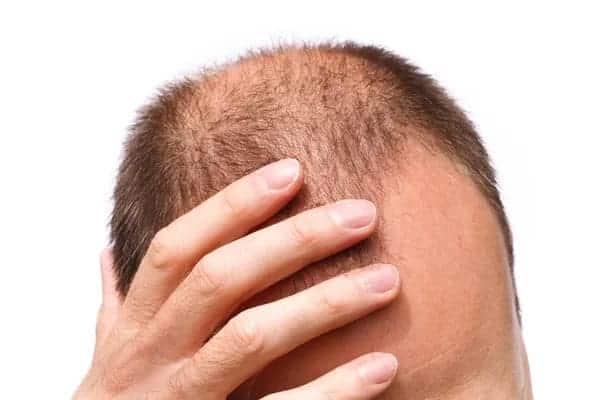Have you ever wondered why men go bald and women don’t? Androgenetic Alopecia is a permanent hair loss condition affecting millions more men than women. On this post, you’ll find out why men lose their hair more than women, how this process happens, and what you can do to cover this condition up.
What is Pattern Hair Loss?
Pattern hair loss (androgenetic alopecia) is a health condition affecting both men and women. It causes permanent hair loss in all sufferers, meaning the affected areas of their scalp will never grow back naturally.
This condition follows a largely similar pattern across all patients. Doctors and hair transplant surgeons can follow the progress of this condition by using the Hamilton-Norwood Scale in men, and the Ludwig Scale in Women.
Pattern baldness is a hereditary condition. This means we’re genetically predisposed to it, and inherit it from our parents. Unfortunately, there is no way to stop this condition without hair transplant surgery.
Male pattern baldness is typified by a receding hairline and thinning crown. Whilst many men may try to hide this with a topical treatment (such as Minoxidil), it will still get worse with age. This condition often gives the appearance of an “m” shaped hairline.
Female Pattern Baldness is categorised as having thinner hair on the top of their head, with the hairless section the mid parting gradually widening as a woman ages.
Androgenic Alopecia: What do the Statistics Say?
Male Pattern Baldness is one of the most prevalent health conditions in the UK today. In an article released by Men’s Health Forum (2022), it was suggested that 66% of all men will suffer with male pattern hair loss at some point in their life. In the UK, that equates to over 7.5 million men!
However, the statistics for women do seem to be slightly less bleak. Only half of women seem to experience female pattern hair loss over their life span. This is seems to be considerably less than men.
The American Hair loss Association found androgenic alopecia to be responsible for 95% of the hair loss cases in men. In women, the NHS estimates the same condition to only affect 30% of women by age 70.
So, what do the statistics say about why more men are going bald than women? Well, hair loss in men appress to be a result of genetic factors that cannot be prevented, even with a healthy lifestyle. Moreover, male pattern baldness also causes permanent hair loss, meaning it will never grow back.
In comparison, permanent hair loss by pattern baldness affects a significantly smaller percentage of women, leaving many other explanations. In women, balding can occur as a result of conditions such as alopecia areata, vitamin deficiencies, and even a stressful lifestyle. Both of these conditions only cause temporary hair loss, meaning women can often get their hair to regrow.
The statistics show men to be greatly more affected by pattern hair loss than women, leaving them with unfixable, permanent baldness. Whilst women also suffer with hair loss, this can be remedied with something as simple as a more balanced diet or a less stressful life.
What Explanations Are There For Pattern Hair Loss?
There are a number of different explanations as to why more men seem to go bald than women. Here are a couple of reasons why:
Androgenetic Alopecia is more Prevalent in men than women
As the statistics have shown, a greatly higher percentage of men inherit the hair loss gene than women. With no way to prevent male pattern baldness, this will naturally lead to more men becoming bald than women. Especially when the vast majority of hair loss in women is treatable.
DihydroTestosterone (DHT) May Quicken Hair Loss
Pattern hair loss is caused by the body’s production of a hormone called dihydrotestosterone (DHT). This hormone binds to your hair follicles causing them to shrink and never regrow. This is what gives the effect of receding, or thinning hair.
As men tend to have naturally higher levels of testosterone (and, as a result, DHT) than women, one explanation may be that this is what causes men to go bald quicker. With more DHT in your body, the quicker your hair follicles will shrink and leave you going bald.
Men’s Hair Loss Is Easier to See
Although this is not to say that hair loss does not affect females, it may simply be that women are better at hiding their baldness than men. As women tend to have their hair in longer hairstyles, it is often easier to cover up and hair thinning or bald patches.
Pattern hair loss may be more visible in men as they do not cover it up as much. Not only do men tend to have shorter hairstyles, there is less social stigma around hair loss in males than females., It may be the case that men tend to worry less about hiding their receding hairline when at work or in public.
Pattern Baldness Typically Affects Different Age Groups in Both Genders
Another explanation may be that pattern baldness tends to manifest in different ages amongst men and women. In females, pattern hair loss most commonly occurs after a woman has gone through the menopause. Although testosterone may not rise, there are naturally lower levels of female sex hormones to fend off pattern baldness.
In men, pattern baldness can begin as early as puberty. With erratic levels of testosterone flowing around your body, it’s no surprise hair loss can begin as early as 17-20. So, pattern hair loss is likely to occur for a longer period of a man’s life when compared to a woman’s.
What Can be Done to Prevent Pattern Hair Loss?
If you have female or male pattern baldness, there is nothing you can do to “stop” or “prevent” this condition. Perhaps a better way to reframe this is to think how your can “slow” or “manage” your symptoms.
Many men and women try to slow down hair loss by using chemical treatments such as Minoxidil or Finasteride. Although clinical studies have shown results to have mixed success, it is generally believed that these treatments are a good preliminary treatment to help manage the first signs of hair loss. Be aware, these will not cause new hair growth, simply slow hair loss.
In more serious cases of pattern hair loss, men and women have also had hair transplants to treat this inherited condition. Hair transplant surgery is the only way to fully restore the hairline and thickness in the crown area. FUE (Follicular Unit Extraction) is the suitable for men and women, and one of the most popular hair transplant treatments we have on offer today!
If you’re not suffering with the pattern balding process, you can aim to fix your vitamin deficiency. After consulting with your doctor, you could definitely try a supplement or hair growth nutrient such as: vitamin a, vitamin d, zinc, iron, or omega 3. This can help to stimulate hair growth in many temporary hair loss sufferers.








